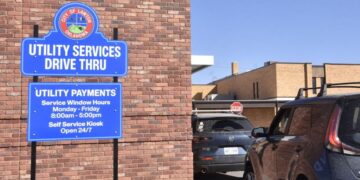It’s about to get serious. “We have a shooting,” Det. Andrew Grubbs announces. “The victim’s at the scene, suspect’s at large. That’s all we know.”
Grubbs turns around and walks to a separate room in the Impact Community Center, 2713 NW 22nd Street. Behind him are 18 excited teenagers, eagerly looking forward to what’s awaiting them at this mock crime scene.
It’s that time of the year again. It’s the annual Junior Citizens Police Academy, organized and hosted by the Lawton Police Department. It’s a one-week camp designed for young adults ages 14-18 to learn more about the diverse field of work in a police department, from crime scene investigators, traffic units and special operations to lake divisions, K-9 units and SWAT teams, among others.
Last Thursday, crime scene investigation was on the schedule. Lawton PD brought its crime scene unit’s van, and Grubbs took the time to present some of the items that are part of that van. Then, Grubbs and his colleague Det. Aaron Molloy taught the kids about fingerprinting and the art of taking fingerprints. And finally, Grubbs led the teenagers into the other room, where a mock crime scene had been set up.
“When we go in, are we touching anything?” he asks. A resounding “no” echoes back.
Anything in the room could be evidence, and touching it or stepping on it could destroy or make it inadmissible in court. The kids carefully position themselves toward the wall, while Grubbs walks through the room and presents the evidence. The most obvious ones: the dead victim as well as several shell casings all over the room.
“We got one, two. …” Grubbs starts counting, “…six, seven bullets.”
Seven shots fired, but the detective work doesn’t end there.
“Where do shell casings come out?” Grubbs asks. The answer “gun” is not enough. “If I fired the gun, where would it come out? If I have a bullet casing right here, what does that tell me?”
The teenagers slowly start getting the idea of how in-depth detective work can be. It is a precise endeavor. Or, in Grubbs’ words, a “puzzle,” and the detective’s job is “to recreate the puzzle.”
The dead victim, played by a dummy with a fake bullet wound in its head, manages (more or less) to sit on one of the chairs in front of one of the tables. The victim provides new clues, but also new puzzles to solve for the detectives.
“We got one gun over here,” Grubbs says as he’s pointing toward the pistol in front of the victim. But, Grubbs adds, there’s “no shell casing.” Why?
Was it suicide? Homicide? Was it homicide made to look like a suicide? And why is there a bunch of cash on the table in front of the victim? Wouldn’t the suspect take that with him, one kid asks.
Most homicides, Grubbs explains, are not about money, but rather jealousy, hate or other interpersonal issues. Money doesn’t play a role very often, Grubbs says.
Step by step, Grubbs then walks the young adults through what’s required of detectives at a crime scene. Looking for clues, coming up with reasons for those clues, photographing and documenting the crime scene properly, the list is long. But the kids have fun.
“I enjoy it, it’s a good class,” Christopher Copeland said. The 17-year-old is in the process of choosing between becoming a firefighter or police officer. Although he said he “knows a lot” about police work, the academy gave him a better insight into the different divisions of a police department, what they do and why they are important, he said.
The SWAT teams and gang units were his favorite part of the academy, Copeland said. “There’s such a crime in part of this town, so this is probably the most important to help protect the community.”
Some participants come into the academy with the goal of becoming a law enforcement officer one day, Christopher Blessing, public information officer of Lawton PD, explained. Most others would think about it by the end of the week.
“It’s a fun, productive week,” he said. “They’re having a blast, they’re loving it.”
There are two main reasons the Lawton Police Department is conducting the academy, Blessing said. One reason is to build relationships and to “open communication lines” between the police and the youth of the community.
“We want them to know that we’re the good guys,” Blessing said. “We are on their side, we do care about their safety.”
The second reason is to give children interested in law enforcement “more of an insight” into police work and to help “ignite that fuel,” according to Blessing.
“It means everything to me to have the ability to change the youth, not only their perspective, but also their mindset to pursue a career.”
Want to reach a local audience and grow your business?
Our website is the perfect platform to connect with engaged readers in your local area.
Whether you're looking for banner ads, sponsored content, or custom promotions, we can tailor a package to meet your needs.
Contact us today to learn more about advertising opportunities!
CONTACT US NOW





